Intersection Sudoku 2
A Sudoku with a twist.
Problem
by Henry Kwok
Image

The Rules of Intersection Sudoku
Like the standard sudoku, this sudoku variant consists of a grid of nine rows and nine columns subdivided into nine 3x3 subgrids.
It has two basic rules:
- Each column, each row, and each box (3x3 subgrid) must have the numbers 1 through 9.
- No column, row or box can have two squares with the same number.
The puzzle can be solved with the help of small digits in the top parts of certain squares.
The small digits stand for the numbers in the squares horizontally and vertically adjacent to the square that contains the set of small digits. The number of small digits in each set can range from a minimum of 2 (in a corner of the puzzle) to a maximum of 4 (in any square beyond the edge of the puzzle).
A Short Demonstration
The square (3, 6) and the square (5, 6) of this puzzle contain a set of four small digits {2, 2, 3, 6} and {1, 2, 4, 5} respectively. If we colour the squares vertically and horizontally adjacent to (3, 6) with blue, and the squares vertically and horizontally adjacent to (5, 6) with yellow, we find that the square (4, 6) is coloured both with blue and yellow. It is the intersection of two sets of coloured squares, hence the name "Intersection Sudoku".
Student Solutions
Image

We received an email from Anna Olszanska, a maths teacher at a school in Warsaw, Poland, telling us that this puzzle was solved by some of her 13-15 year old students during the School Sudoku Challenge. The best time was 19 minutes and was achived by Maja.
Well done Maja.
